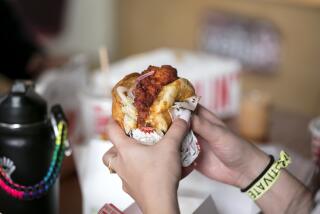Cravings: Giving In
- Share via
We always want what we shouldn’t have. The more we try to talk ourselves out of eating chocolate-covered peanuts or fudge-ripple ice cream, the more we crave them.
This is especially true for dieters, who frequently deprive themselves of the foods they desire most. Sometimes, the avoidance becomes unbearable and the binger polishes off a bag of candy or a half-gallon of ice cream.
“Things that are forbidden are more attractive,” says Marsha Hudnall, program director of nutrition at Green Mountain at Fox Run, a weight-management center in Ludlow, Vt. “When you completely avoid certain foods, that’s when you get into real trouble.”
The solution, say Hudnall and other weight-loss experts, is to cave in to your cravings. Plan to eat moderate portions of your favorite high-fat, high-calorie foods once in a while; it’s physically and psychologically preferable to the cycle of abstention and overindulgence.
What’s more, Hudnall says, “after a period of time, you won’t be so attracted to them.”
People who have completed liquid diets may be particularly prone to cravings, bingeing and regaining weight, Hudnall says, because of such diets’ prohibitive approach regarding solid food.
The Federal Trade Commission recently charged three companies that market liquid-diet programs with deceptive advertising, including unsubstantiated claims about maintaining long-term weight loss.
Elizabeth Markley, an assistant professor at the School of Allied Health at the University of Connecticut, said there is increasing evidence that dieters end up uncontrollably craving the foods they deny themselves.
Markley, who also does private nutrition counseling, advises clients who want to avoid bingeing to eat the food they crave before they crave it. “If you really like pumpkin pie, plan to have a piece rather than wait until you can’t stand it anymore,” she says.
But maintain a balanced diet, and let your activity level and caloric needs determine quantity, Hudnall said. She warns that for some people, “One Hershey Kiss will drive them nuts.”
Linda Crawford, an eating-behavior specialist at Green Mountain, tells people who fear these “trigger foods” to learn to “eat just one.”
Crawford says she had a severe bingeing problem for 16 years. She would buy a dozen doughnuts, eating six in the car and the rest when she got home. She broke the cycle by carefully selecting and buying a single doughnut and eating it slowly.
She also realized that wanting more didn’t mean she had to have more. Some dieters feel that if they eat one cookie, they may as well eat the whole bag, Crawford said. Aside from learning that there are no “illegal foods,” dieters should look realistically at weight management. “One brownie doesn’t make anybody fat,” Crawford said.
Crawford suggested making a single treat available by buying a one-scoop cone at the ice-cream shop, one cup of a soft drink at the convenience store or one turnover or doughnut at the bakery.
Other weight-loss experts say eating is an addictive disease for many people and don’t agree that these individuals can learn to stop at one. Janet Laubgross, a Fairfax, Va., clinical psychologist who specializes in weight management, says there is a subset of people who know that once they eat a chocolate-chip cookie, they can’t stop. Therefore, she says, they shouldn’t start.
But Laubgross notes that “all of us use food for reasons aside from hunger.”
Do you crave food because you are frustrated or upset? She suggested learning other coping skills. Alleviate stress by exercising, taking a bath, listening to music or reading, she says.


